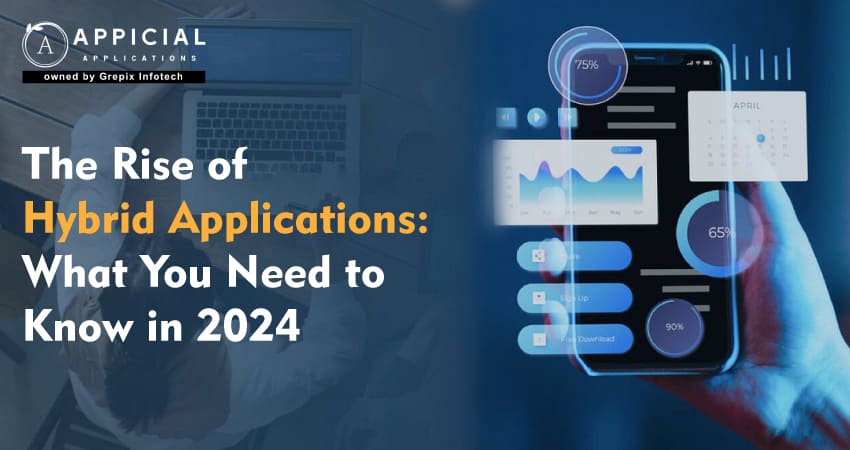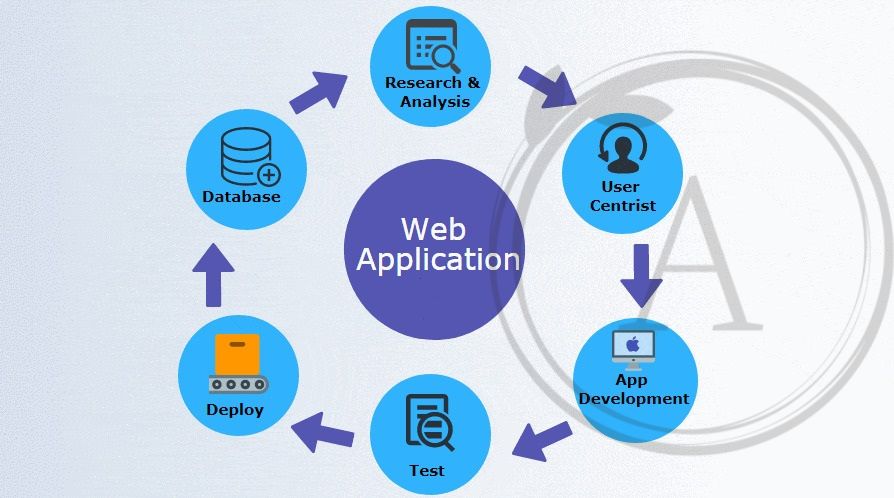
The Rise of Hybrid Applications: What You Need to Know in 2024
Hybrid applications are rapidly becoming a cornerstone in the tech world, especially as we stride into 2024. Blending the best of both web and native mobile apps, these robust solutions offer a unique combination of performance, versatility, and cost-efficiency that’s hard to beat. Whether you’re a developer eager to streamline your coding process, or a business looking to expand its digital footprint, understanding the landscape of hybrid applications is crucial. In this blog, we'll delve into why hybrid apps are gaining such momentum and what you need to consider to stay ahead in the tech game.
The blog discusses the increasing importance of hybrid applications in 2024, highlighting their unique blend of web and native app functionalities. These applications offer significant benefits such as cost efficiency, faster development, access to device features, and ease of updates, making them increasingly popular among developers and businesses. The article covers the definition, benefits, and challenges of hybrid apps, comparing them with native and web-only applications. It also explores necessary skills for developers and the impact of emerging technologies like AI, AR, and IoT on hybrid applications, forecasting strong market growth and innovation in the sector.
The Rise of Hybrid Applications
Hybrid applications, often referred to as hybrid apps, are an innovative type of software that combines elements of both native apps and web applications. As we advance further into 2024, the popularity of these applications continues to grow, making it a critical topic for developers and businesses alike.
Definition and Overview of Hybrid Applications
Hybrid applications are essentially web apps built using HTML5, CSS, and JavaScript, but they are encapsulated within a native application. Using platforms like Apache Cordova (formerly PhoneGap) or Ionic, these apps run web content in a native WebView browser embedded within the app. This unique structure allows hybrid apps to access device-specific capabilities such as the accelerometer, camera, and local storage, which are generally accessible only to native applications.
Benefits of Hybrid Applications
The primary advantage of hybrid apps is that they blend the best aspects of native and web apps. Here are some benefits that they offer:
- Cost Efficiency and Faster Development: Developers can write the code once and deploy it across multiple platforms, significantly reducing development time and cost.
- Access to Device Features: Despite being based on web technology, hybrid apps can utilize device features just like native apps.
- Ease of Updates: Updating hybrid apps is simpler because most of the resources are web-based and can be updated without needing to push changes through an app store.
- Broader Reach: Since hybrid apps can be distributed over app stores and also function as web applications, they can reach a wider audience across multiple platforms using a single codebase.
- Comparison with Native and With appealing benefits hybrid apps also come with their own set of limitations. To provide a comprehensive view, it is beneficial to compare hybrid applications with native and web-only applications
- Performance: Native apps generally provide the best performance and the smoothest user experience as they are developed specifically for a certain platform. Hybrid apps, while significantly improved, can still lag behind native apps in terms of responsiveness and performance.
- User Experience: Native apps tend to have a better user experience since they are designed with the platform's specific guidelines in mind. Hybrid apps, however, have made considerable strides in closing this gap with advancements in technology.
- Development Cost and Time: Web applications and hybrid apps require less time and money to develop than native apps. Hybrid apps, though slightly more expensive than web-only apps, are still more cost-effective than native by offering a middle-ground solution.
- Market Reach: Web apps can be accessible to anyone with a browser, while native apps benefit from visibility in app stores. Hybrid apps combine these strengths, providing app store presence as well with easier deployment.
Importance for Developers
As hybrid applications continue to gain traction, developers must adapt by acquiring new skills and embracing new technologies to stay competitive in the industry.
Skills Needed for Developing Hybrid Applications
Hybrid app development requires a diverse set of skills to efficiently bridge the gap between web-based and native technologies. Key skills include:
- Proficiency in Web Development: Strong foundational knowledge in HTML, CSS, and JavaScript is essential.
- Understanding of Native Development: Familiarity with native development environments for iOS (Swift or Objective-C) and Android (Java or Kotlin) can be invaluable.
- Experience with Hybrid Frameworks: Mastery over frameworks like Ionic, React Native, Flutter, or Cordova can give developers a significant edge.
- API Integration: Ability to integrate various APIs and external services proficiently.
- Performance Optimization: Skills in optimizing performance to make the app as responsive as possible.
Tools and Technologies for Hybrid App Development
A wide range of tools and technologies are available to help developers create effective hybrid applications. Some of the most popular tools include:
- Ionic: This open-source framework allows developers to build apps using web technologies that run on both iOS and Android.
- React Native: Created by Facebook, this framework lets developers build hybrid apps using React along with native platform capabilities.
- Flutter: Developed by Google, Flutter uses the Dart language and provides a unique approach to creating high-performance apps.
- Apache Cordova: This platform provides a set of device APIs that allow a mobile app developer to access native device function such as the camera or accelerometer from JavaScript.
- Xamarin: A Microsoft-owned tool that uses C# and .NET framework to create Android and iOS apps with a single shared codebase.
Challenges Faced by Developers
Developing hybrid applications presents developers with a set of challenges that must be managed effectively:
- Performance Issues: One of the most significant challenges is the potential performance hit when compared to native apps, especially for complex or high-graphic applications.
- Maintaining Consistency: Achieving a consistent look and feel across different platforms can be difficult, given the variations in screen sizes, resolutions, and platform-specific behaviors.
- Limited Device Feature Access: While recent advancements have improved access to device-specific features, some capabilities might still be limited compared to native applications.
- Debugging: Debugging hybrid apps can be more complex than native apps because they involve multiple layers of technology stacked together.
Understanding these challenges can help developers anticipate potential obstacles and plan strategies to mitigate them, ensuring the successful development of hybrid applications.
Impact on Businesses

The rise of hybrid applications is reshaping how businesses approach digital product development. Hybrid apps combine elements of both native and web applications, which lead to various benefits including seamless user experiences across different platforms and devices. This pivotal shift is influencing several aspects of business operations from cost management to expanding customer reach.
Cost-Effectiveness and Time Efficiency
One of the most significant impacts of hybrid applications on businesses is the cost-effectiveness and time efficiency in app development and maintenance. By using a single codebase that runs on multiple platforms, companies can save substantial resources in development and updates which would otherwise be needed for separate native apps. Here are some ways hybrid apps drive financial and operational efficiency:
- Reduced Development Costs: Developing one app that runs everywhere cuts down the costs compared to creating multiple native apps for iOS, Android, and other platforms.
- Faster Time to Market: Hybrid applications can be developed and launched faster than their native counterparts because they require less coding and testing.
- Simplified Maintenance: Maintaining and updating hybrid apps is easier and cheaper as changes need to be made only once in the shared codebase, rather than in several codebases.
Also Read: Innovative Solutions from the Best Mobile App Development Company
User Experience and Customer Reach
Hybrid applications not only streamline development processes but also enhance user experience and expand customer reach. These apps can perform well across different platforms and devices, providing a cohesive user experience that closely competes with native apps. Enhanced UX leads to greater user engagement and retention. Moreover, by being accessible on various devices, hybrid apps help businesses reach a broader audience, including people using less common operating systems. Key benefits include:
- Consistent User Experience: Hybrid apps provide a consistent look and feel across all platforms, which is crucial for brand identity and user satisfaction.
- Broader Market Penetration: With the ability to function across multiple platforms from a single development project, businesses can target users on less popular platforms without extra investment.
Case Studies of Successful Hybrid Applications
Several major companies have leveraged hybrid application technology to significant effect. For example, Instagram and Uber have utilized hybrid technologies to enhance user accessibility and maintain a consistent experience across multiple platforms.
- Instagram: Initially, Instagram used native tools to build a high-performance app but later incorporated HTML5 to make their app faster and more responsive across platforms.
- Uber: The Uber hybrid app works effectively on various devices, ensuring fast booking experiences whether on a smartphone, tablet, or desktop, thanks to its responsive, cross-platform design.
These success stories showcase the strategic advantage hybrid apps can offer, combining rapid deployment with high performance and broad reach.
Technology Trends in 2024
As we move forward, hybrid applications are set to become even more sophisticated with the integration of advanced technologies like AI, AR, VR, and IoT. These integrations promise not only to enhance the functionality of the hybrid apps but also to revolutionize the way businesses engage with users. AI and Machine Learning Integration.
Artificial Intelligence (AI) and Machine Learning (ML) are making their way into hybrid applications, offering smarter, context-aware functionalities that can learn from user interactions to enhance personalization and efficiency. The integration of these technologies allows hybrid apps to offer features like predictive text, intelligent assistants, and personalized content. This not only improves the user experience but also gives businesses valuable insights into user behavior and preferences, which can drive strategic decisions.
Augmented Reality and Virtual Machinery Features
Augmented Reality (AR) and Virtual Reality (VR) are poised to transform the user engagement strategies in hybrid applications. These technologies are being leveraged to create immersive experiences that blur the lines between digital and physical worlds. For example, retail apps can enable virtual try-ons, and gaming apps can offer more immersive environments. This can significantly increase user engagement and satisfaction, providing a competitive edge to businesses that adopt these features early.
IoT Connectivity in Hybrid Applications
The Internet of Things (IoT) connectivity is another transformative technology trend being integrated into hybrid applications. IoT allows hybrid apps to communicate with smart devices and sensors, providing users with seamless experiences across their devices and environments. This interconnectivity can be particularly useful in applications ranging from smart home controls and health monitoring systems to industrial IoT solutions that streamline operations and enhance data-driven decision making. The integration of IoT into hybrid apps not only improves user experiences but also opens new avenues for automation and innovation in businesses across various sectors.
As we adapt to the swiftly changing digital landscape, hybrid applications continue to evolve, driven by advancements in technology and shifting consumer expectations. For developers and businesses alike, staying ahead of these trends is crucial in leveraging the full potential of hybrid applications to achieve competitive advantage and operational excellence in 2021 and beyond.
Future Prospects of Hybrid Applications
Market Predictions and Growth
The future looks incredibly bright for hybrid applications as they continue to carve a substantial niche in the global market. Analysts predict that the market for hybrid apps will witness a compound annual growth rate (CAGR) exceeding 20% from 2024 to 2029. This growth is fueled by the increasing demand for seamless user experiences across multiple platforms and the cost-effectiveness of developing one app that fits all. Leading industries such as retail, banking, and healthcare are expected to ramp up their investment in hybrid technologies to enhance customer engagement and operational efficiency.
Emerging Innovations in Hybrid App Development
Emerging innovations in hybrid app development are revolutionizing the digital landscape, blending the best of both web and native technologies. Modern frameworks like Flutter, React Native, and Ionic are pushing the boundaries, enabling developers to create high-performance, cross-platform apps with a single codebase. These advancements enhance user experience, reduce development time, and lower costs, making hybrid apps an increasingly attractive option for businesses. As technology evolves, hybrid app development continues to offer versatile and robust solutions, meeting the growing demand for seamless, scalable, and efficient mobile applications.
Conclusion
The trajectory of hybrid applications is undoubtedly pointing upwards. With their ability to streamline development processes and reduce costs, while providing a rich and interactive user experience, it's clear why they are becoming a preferred choice for both developers and businesses. As technology evolves, it will be fascinating to see how hybrid applications adapt and transform to meet future challenges and consumer demands. For anyone keeping an eye on technology trends, hybrid apps are a field worth watching.
Launch your vision with our mobile app development company, where innovation meets excellence to create cutting-edge mobile solutions.





